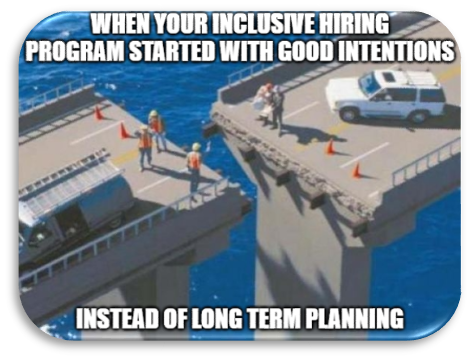When Good Intentions Aren’t Enough: Building a Responsible Hiring Foundation
Strong inclusive hiring starts with clarity, structure, and long-term thinking. Here’s how to build a responsible hiring foundation that lasts.
There’s a big difference between launching a hiring initiative and building a hiring system. Most organizations have the intention to do better—but intention alone won’t bridge the gap between your talent goals and actual results.

This meme is funny because it’s true.
A lot of inclusive hiring efforts look like that bridge: well-meaning on both sides, but no structure in between. And the farther you try to go without the right foundation, the more likely things are to break down.
If you’re serious about inclusive hiring, you need more than enthusiasm.
You need responsible hiring—a structured, long-term approach grounded in three critical areas: Access, Support, and Integration.
Access: Open the Door Before You Invite People In
Access is more than outreach. It’s your first impression—and your first barrier if you’re not careful.
Many organizations unintentionally screen out great candidates before the conversation even begins. Vague job descriptions, inaccessible platforms, or unclear expectations can quietly send the message that some people aren’t welcome—even when you’re trying to do the opposite.
Here’s what to fix:- Rewrite job descriptions to focus on core competencies and plain language.
- Make sure your application platforms are compatible with screen readers and assistive tech.
- Partner with community organizations that already serve candidates with disabilities and neurodivergence.
- Real-world tip: The most inclusive companies don’t wait for talent to find them. They go out and build trusted relationships in the community.
Real-world tip: The most inclusive companies don’t wait for talent to find them. They go out and build trusted relationships in the community.
Support: Prepare People, Not Just Paperwork
When you bring someone in, how do you set them up for success?
Support isn’t about offering accommodations when asked. It’s about building a culture where those accommodations are already expected—where candidates don’t have to advocate for themselves just to get the tools they need.
Support shows up in three places:
- For hiring teams
Training on inclusive interviewing, neurodivergent communication, and bias-aware evaluations. - For candidates
Preboarding resources that explain what to expect, how to prepare, and who to talk to. - For managers
Real-time access to accommodation workflows and ongoing coaching.
Quick fact: Companies that provide structured support see higher engagement and retention—especially in the first 90 days.
Integration: Make Inclusion a Habit, Not a Headline
When inclusion lives outside your everyday systems, it becomes fragile. But when it’s integrated into onboarding, evaluations, team dynamics, and feedback loops, it becomes second nature.
- Inclusive language and examples in all training—not just the DEI module.
- Feedback from disability employee resource groups (ERGs) used to inform real policy change.
- Accommodations built into onboarding checklists, not tacked on later.
Pro Tip: If your hiring managers say, “I forgot (didn’t know) we had that program,” integration hasn’t happened yet.
Conclusion: Don’t Build a Bridge You Can’t Cross
You don’t need to launch the perfect program all at once. But you do need to build with intention—because patching over gaps later is always more expensive than getting it right at the start.
If you’re feeling the gap between your goals and your results, don’t just push forward. Pause, assess, and invest in the structure that will carry your efforts long-term.
What part of your hiring process feels the most disconnected right now—Access, Support, or Integration?
Let’s Connect
Click here contact@sourceabled.com to connect with a Rangam SourceAbled team member to discuss how our TalentArbor technology can help you fill those gaps, and build a stronger lasting foundation.

